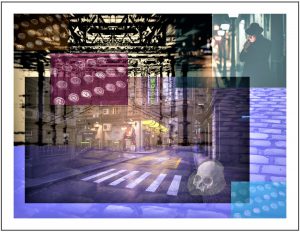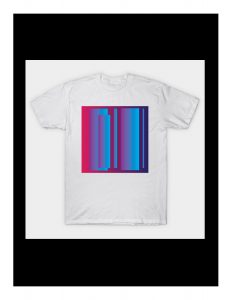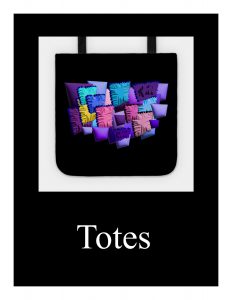
Play invigorates the mind and informs our design work, opening the way for countless new projects to unfold. The exploration of ideas, the discovery of new forms and colors, can occur when least expected, especially when playful experiments are underway. Will your journey through playtime lead to a new line of clothing or, perhaps, a series of paintings and prints? There is always the chance that it could, that a fortunate combination of elements might launch your career. However, even if not, you will enjoy a bit of refreshment and create a collection of ideas for the future.
Thanks to the rise of print-on-demand websites, graphic design options abound, decorating everything from shirts and mugs to wall coverings and phone cases. Shiny and bleeding with color, or bold and austere, whatever style you seek, it’s sure to be found somewhere in virtual reality. Or, if not, it awaits the creative expression of a designer, amateur or professional. But how can we begin this process? A square, a simple geometric form, offers us a wonderful point of departure.
This is where I typically begin, and sometimes remain for the duration of the project. A simple form underwrites the space. From there, I can add sketches or overlay sets of transparencies. In the best-case scenario, a new design takes shape and offers itself to multiple applications. What else can we do to inspire play?
Collage Creation with Clipart and Photos
Assembling ideas with vector art and photos is a regular practice among professionals and hobbyists alike. Beyond project development, however, the activity is simply fun and relaxing, a wonderful way to create possibilities for the future. To begin, just cut and paste images into a publisher document and experiment with the arrangement of forms.
As for my own design work, most of it arises from experimentation, just moving shapes and colors around to see what transpires. When a session goes well, I might have new artwork for shirts or any number of accessories. More than anything, I enjoy the process; just fill the page with random images, experiment with transparency and size, and create a series of collages to launch your next project.

The Interdisciplinary Approach: Architecture and Writing
You can utilize architectural photos and drawings to hone your drafting skills, either by creating detailed, photorealist copies, or by transforming the vernacular of forms you discover into something new, a fresh perspective for your upcoming projects. Architects like Louis Kahn and Frank Lloyd Wright—to name just two—are useful to study. Both successfully translated their conceptions of space into magnificent structures, the likes of which can teach students of graphic design a great deal. Consider Kahn’s use of volume and light and how you, as a designer, might translate his approach into a two-dimensional representation, invigorating your typography and negative/positive spaces. Here, I have in mind the National Assembly Building of Bangladesh and the magnificent shadows it casts at various times of day. Can you incorporate these shapes into your work? Or, perhaps, you favor the sweeping horizontal lines of Mies van der Rohe, modernist architect of renown. Dividing your artboard with long shapes could recall the minimalist impact of his work. In any event, studying architectural photos and drawings—as well as the various philosophical perspectives of practitioners—is a wonderful way to enrich your design practice. Next, we consider how the written word can help to generate visual representations.

From Text to Image: Constructing the Story
Each expression of language has texture, be it a smooth, solitary word standing on its own, or a gathering of jagged phrases disrupting the page. As a designer, you can make use of these qualities; take the story from an entire page of text, or simply extract a phrase, and use forms to retell the events. For example, “He landed with a resounding thud on the wet pavement.” Of course, you can draw a depiction of the event, a figure crashing to the ground at an inconvenient moment. Apart from that, you can abstract the characters and elements into random forms, none of them bearing any resemblance to the written account. From there, you can place them on the page, accenting each one carefully with unanticipated colors and textures. Although no one will recognize the original subject, you, as the designer, might have an innovative new set of forms to utilize. In this manner, the texture of language can move from written to visual expressions with ease, inviting you to create your most insightful designs.

Building a New Series
After you find pleasing combinations, you are ready to apply them to your print-on-demand products. As you experiment with the techniques described above, your repertoire of designs will quickly increase.

